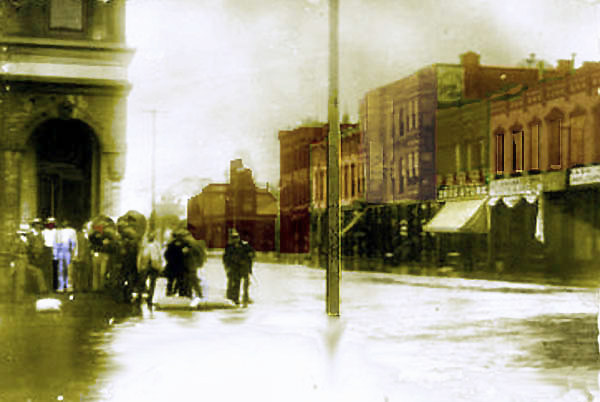
"A Rainy Afternoon in Cheyenne," Artwork by
Geoff Dobson, based on a photo.
The above image depicts a group crowded into the entrance of the Idelman Building avoiding a passing rain and
flooded street.
To the east in the distant through the rain may be seen the Burlington Station. Toward the viewer On the southeast corner of 16th and
Capitol is the Normandie Hotel (formerly the Phoenix Block now the Wrangler Building). In the center of the block is the Atlas Building.
The shadow of the Tivoli Saloon may be seen on the lower right-hand
side of the image. In the one city block bounded by Capitol Ave., 16th Street, and
15th Street shortly after the beginning of the Twentieth Century were the leading hotels of
Cheyenne. In addition to the Interocean hotel, Other leading hotels included the Metopolitan on the southwest corner of
15th and Carey, the Hotel Becker originally situated at 1506-1510 Capitol Avenue operated by Henry Becker which after
being jacked-up and physically moved southward became the Albany.
Charles Becker in 1910 constructed a replacement on 15th Street one-half block west of the railroad depot.
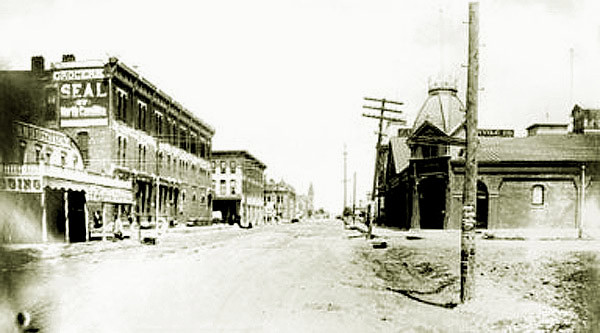
View of Hill Street (present day Captiol). On the left is "G. L. Taylor's Curiosities," the Phoenix Bloxk,
the Interocean Hotel, and the Opera House. On the right is the Warren Emporeum (later the Burlington Station).
The Burlington arrived in Cheyenne from Colorado by way of Carpenter in 1887. To provide a station the Burlington purchased the Emporium. Thus, the above photo
would date to prior to 1888.
The Phoenix Block originally housed commercial stores on the ground floor, offices and rental units on the upper floors. It, as discussed further
below, became the Normandie Hotel.
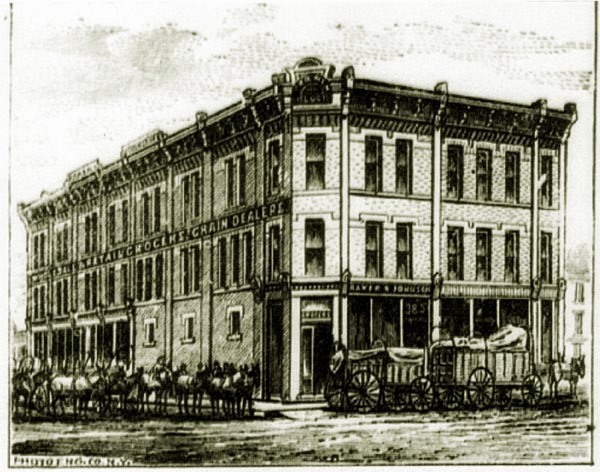
Phoenix Block, southwest corner of Hill Street (present day Captiol) and 16th Street (present day Lincoln Way),
approx. 1887-1888.
Gradually the rental units were converted into hotel rooms so that by 1889 the hotel advertised that it could host 150 guest at
$2.00 and $2.50 per day, competitive to the Inter-Ocean which advertised rates of $2.00, $2.50, and $3.00 per day. The Hotel was conveniently located, only one-half block from the Union Pacific Depot and immediately across the street from the
Burlington station. With plumbing in each room, the hotel was regarded as "upscale" By 1911, the Normandie, the Becker on 15th Street, the Metropolitan on
Ferguson south of the Tivoli, and the Albany south of the Normandie were popular with visitors to the city.
Ranchman Mark M. Coad (1831-1911) was a regular guest of the hotel. Code was one of the pioneers in
Western Nebraska. His ranch formed the basis for the giant Bay State Cattle Co. After selling to Bay State, he created a new ranch in Fremont County Nebraska which was famous for its
Percherons and coach horses. In Wyoming, he formed a 12,000 acre ranch near Horse Creek. On January 4, 1911, Coad returned from a business trip to Denver. For several days previously, a swarthy
a small sheepherder from Coad's ranch at Little Horse Creek had been inquiring for Coad. The sheepherder,
Francisco S. Garrido, had previously been a Roman Catholic divinity student in Spain. and apparently been discharged by Coad's foreman. As Coad was sitting at the
writing desk in the hotel lobby, Garrido appeared and apparently demanded his pay.
Words were exchanged. Four shots were fired. Coad staggered to the cigar counter and fell to the floor dead. Garrido fled into the railyards south of the depot, firing shots at anyone he saw.
About an hour later, he was captured by city police and sheriff's possemen in a
cattle pen in South Chyenne. he was sent to the State Penitentiary where he
committed suicide.
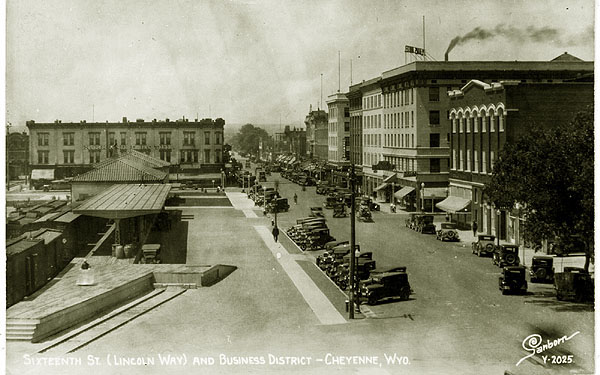
Lincoln Way looking West, 1930's.
In the distance is the Normandie Hotel. As will be observed the original Burlington
Station was razed about 1928 and replaced about 1930 with a Spanish Revival style station. To the right will be observed the Plains Hotel,
the Hines Building, the Majestic Building and the Hobbs, Huckfelt and Finkbiner furniture store and funeral parlot,
later the Grier Furniture Company discussed on a later page.
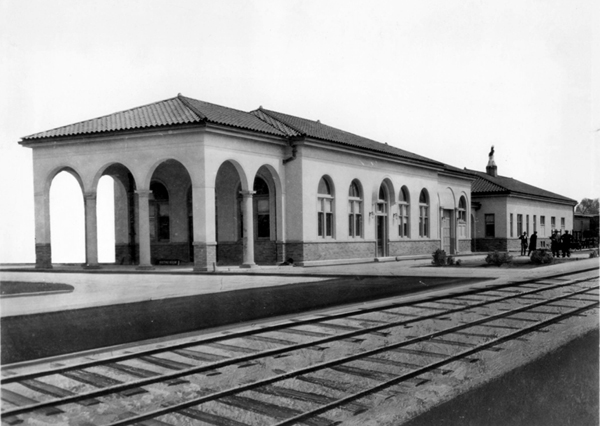
Burlington Station approcimately 1930.
The hotel was somewhat inconsistent with the spelling of "Normandie" and Normandy." The writer has found advertisments spelling the name both ways. On the hotel iself
as will be observed in the next photograph, there are both spellings. The vertical sign on the left in the
photo it is spelled "Normandie" and on the sign over the entrance "Normandy."
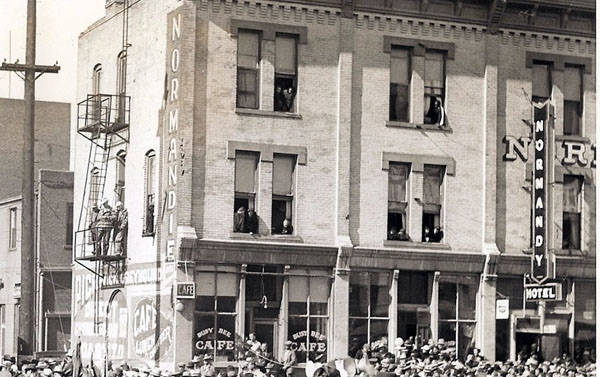
Crowd gathered in front of the Normandie Hotel and the "Busy Bee" Cafe," 1936
The Crowd is gathered for President Franklin Roosevelt's train. The president visited Cheyenne on October 12, 1936. See next photo. The Busy Bee was started by
Theodore Zervas an emigrant from Greece.
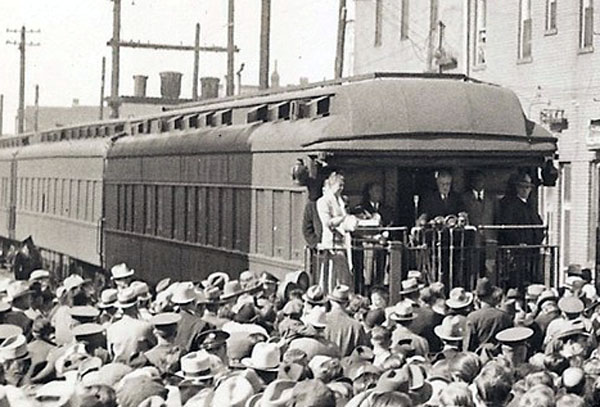
President Roosevelt's train on Burlington tracks located just to south of the Normandie Hotel, 1936
At some point the Normandie Hotel received a coat of yellow paint. In 1943, the building was partially occupied by the Wrangler. During the late 1940's and 50's the Normandie was replaced by the Edwards Hotel and the Busy Bee
by the Edwards Cafe discussed on the next page.
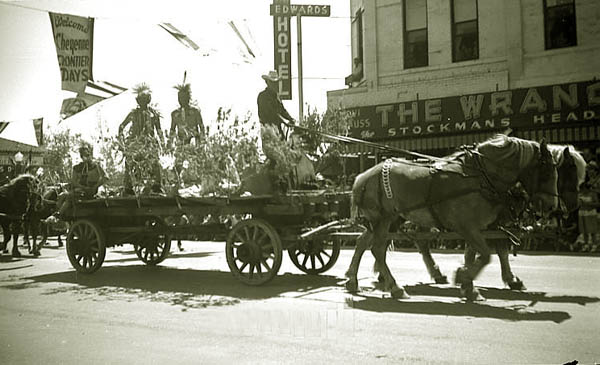
corner ofn the old Normandie Hotel Building showing both the Wwangler and the new
Edwards Hotel Sign, undated.<
in the background may be seen the new Burlington Station discussed on a later page.
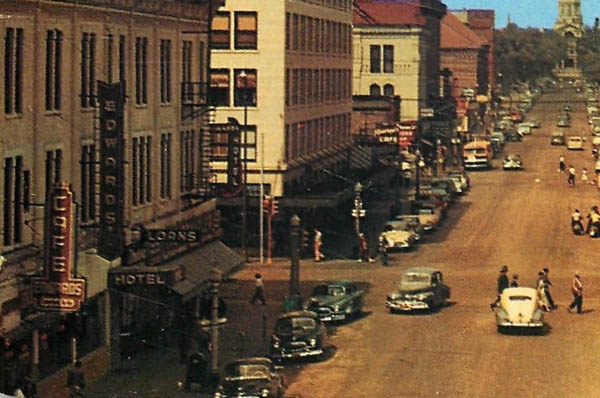
Edwards Hotel, approx. 1952.
Country superstar Reba McEntire in her memoir "Reba: My Story," Bantam Books,2014, noted that her professional
career started at the Edwards Hotel. When she was about five years old, her family went to
Cheyenne Frontier Days and stayed at the Edwards. Her father, Clark McEntire was a champion roper and was her grandfather
John McEntire who was champion roper of the World in 1934. She recalled that there were cowboys everywhere.
At the Edwards there were no televisions in the rooms but there was one set in the lobby so that when there was nothing else to do,
everyone gathered in the lobby. One of the cowboys asked her older brother Pake McEntire if he could sing.
He sang "You Ain't Nothing but a Hound Dog" Young Reba asked her bother if she could sing. She sang
"Yes, Jesus Loves Me," and received a nickle for her efforts. Thus began her professional career.
Although, her father was thrice champion roper and a member of the Professional Rodeo Cowboys Association, rodeos were not
particularly renumerative. She recalled that one year, 1947, her father was the fifth highest earning roper with total
compensation of $1,322. In his best year 1957, he earned $5,184.
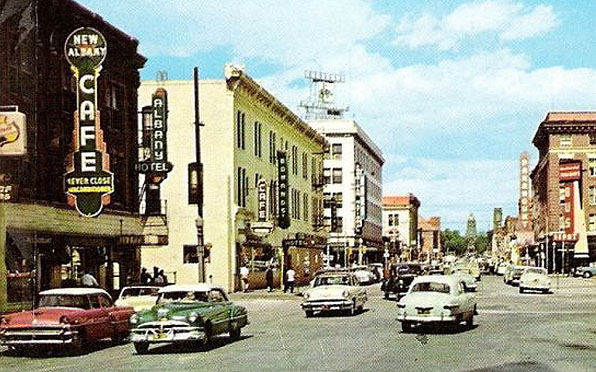
Edwards Hotel, approx. 1955.
The Wrangler Building is now completely occupied by the Wrangler and has been painted a vibrant red and white.
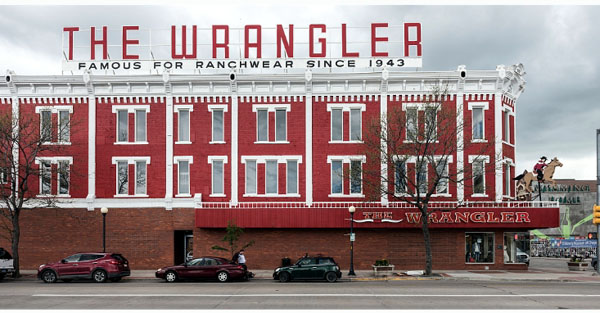
Wrangler Building, 2015. Photo by Carol Highsmith, courtesy of Library of Congress.
Regardless of the coat of paint, a rembrance of the old Normandie Hotel has been preserved in the foorm of an
old "ghost sign" on the Lincoln Way side of the building.
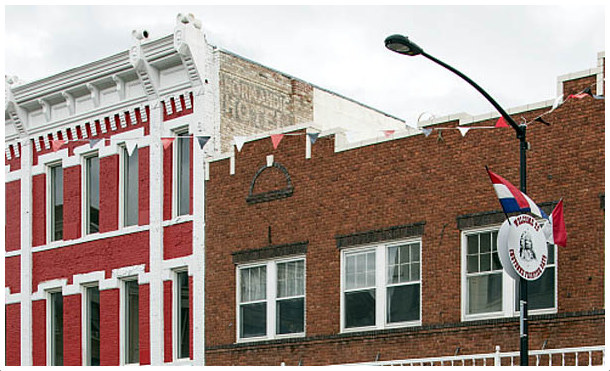
"Ghost Sign" on west wall of the Wrangler Building, 2015..
Next Page: The Albany Hotel Building.
|